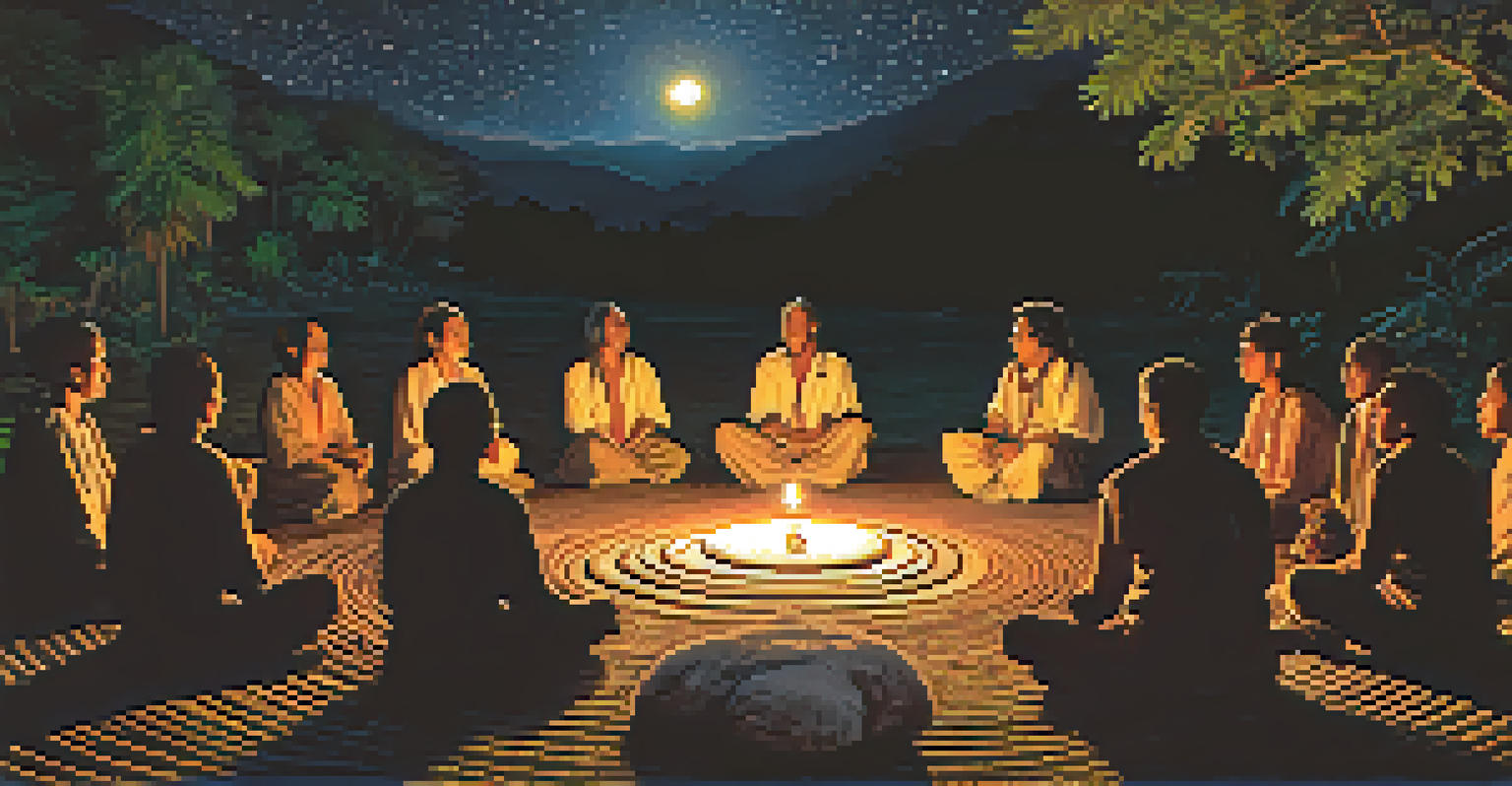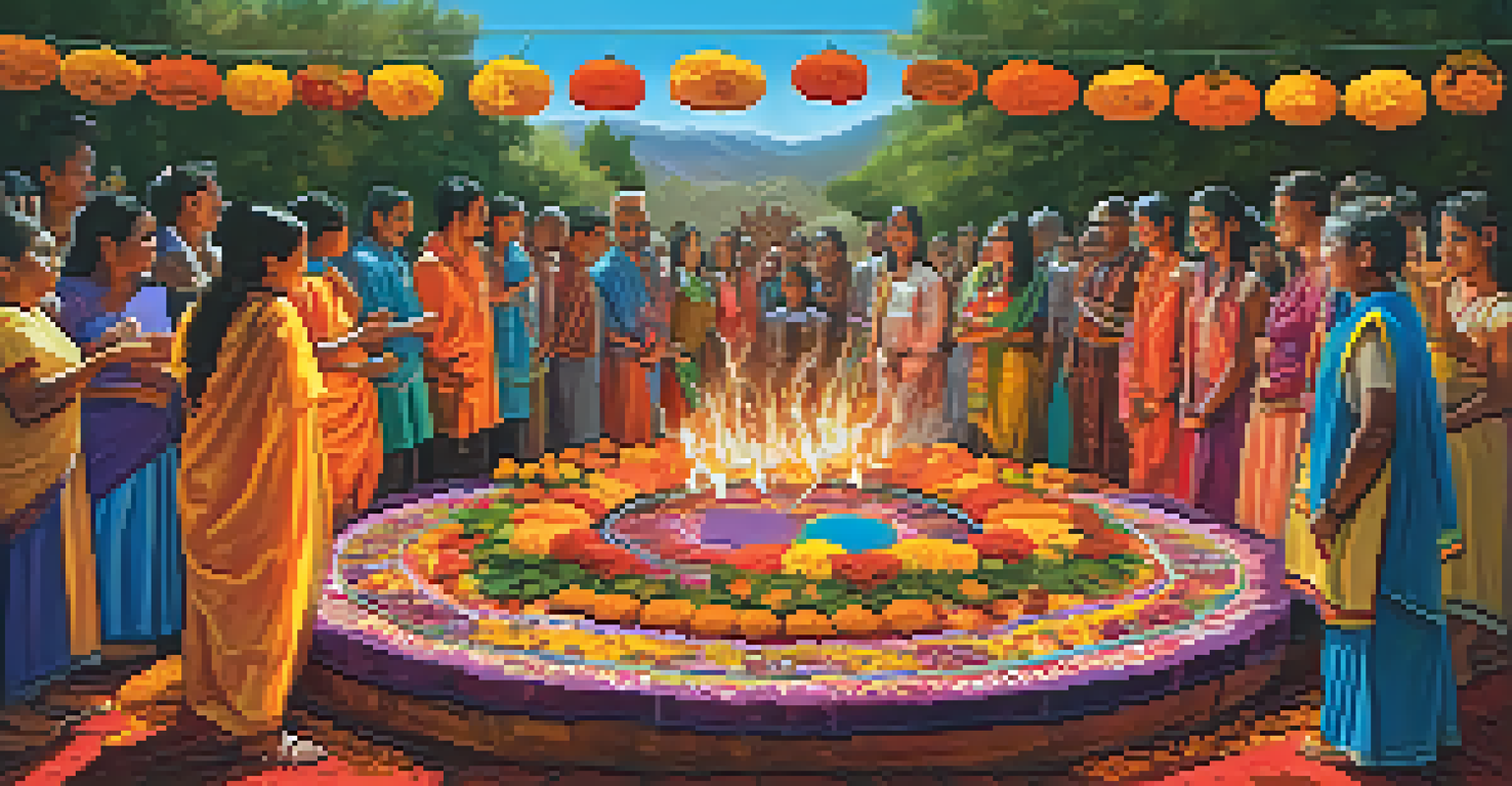Comparative Analysis of Ritualistic Practices with Ayahuasca

Understanding Ayahuasca: Roots and Rituals
Ayahuasca is a sacred brew originating from the Amazon rainforest, traditionally used in spiritual ceremonies. It often consists of two primary ingredients: the Banisteriopsis caapi vine and the leaves of the Psychotria viridis plant. These components work together to create a powerful psychoactive experience, guiding participants on a journey of self-discovery and healing.
Rituals are the formula by which harmony is restored.
The rituals surrounding Ayahuasca involve a shaman or guide who facilitates the experience, ensuring participants are safe and spiritually prepared. The preparation often includes fasting and setting intentions, which are critical to the effectiveness of the journey. Through these rituals, individuals can connect deeply with their inner selves and the natural world, fostering a sense of unity.
What makes Ayahuasca unique is its blend of spirituality, community, and personal introspection. This combination not only enhances the individual experience but also reinforces the cultural significance of the practice within indigenous communities, making it a rich field for comparative analysis with other rituals.
Comparative Rituals: Understanding Their Purpose
Rituals, in a broader sense, serve as structured activities that provide meaning and connection within various cultures. From religious ceremonies to secular gatherings, rituals help individuals navigate life’s milestones, such as births, marriages, and deaths. Their purpose often revolves around creating a sense of belonging and shared identity among participants.

When comparing Ayahuasca ceremonies to other ritualistic practices, such as Buddhist meditation or Native American sweat lodges, we see common threads of intention-setting and communal support. Each practice offers a unique path to enlightenment, healing, or connection with the divine. These similarities highlight the universal human desire for understanding and transcendence.
Ayahuasca: A Journey of Healing
Ayahuasca ceremonies offer profound emotional breakthroughs and personal growth through guided spiritual experiences.
Furthermore, the emotional and psychological benefits of participating in rituals cannot be overstated. They provide participants with a structured environment to process experiences, share stories, and find comfort in community, which is a vital aspect of mental well-being.
The Role of the Shaman in Ayahuasca Ceremonies
In Ayahuasca rituals, the shaman plays a crucial role as a spiritual guide and healer. This individual is often deeply knowledgeable about the plants, the brew, and the spiritual dimensions involved in the ceremony. Their presence offers reassurance and expertise, helping participants navigate their experiences safely.
Healing takes courage, and we all have courage, even if we have to dig a little to find it.
The shaman's role can be compared to that of priests in other religious practices, who lead congregations through rituals and provide spiritual guidance. Both are seen as intermediaries between the sacred and the everyday, helping participants access deeper truths about themselves and their place in the universe.
By facilitating the ritual, the shaman invokes the collective energy of the group, often using songs, chants, or icaros (traditional songs) to enhance the experience. This communal aspect underscores the importance of connection and support, which is a common theme across various spiritual practices.
Cultural Significance of Ayahuasca and Other Rituals
The cultural significance of Ayahuasca extends beyond individual healing; it is deeply embedded in the traditions and identity of indigenous Amazonian tribes. These rituals are a way to maintain cultural heritage and pass down knowledge through generations. In this context, Ayahuasca serves not just as a substance, but as a bridge connecting individuals to their ancestry and communal values.
Similarly, other rituals worldwide, such as the Day of the Dead in Mexico or Diwali in India, play vital roles in preserving cultural identities. They are expressions of collective memory and shared beliefs that foster community cohesion. Such practices remind participants of their roots and reinforce the values that shape their lives.
The Shaman's Guiding Role
The shaman serves as a vital spiritual guide, facilitating safe and meaningful journeys for participants during Ayahuasca rituals.
When exploring the cultural significance of these rituals, we see that they often serve as a means of coping with existential questions and societal changes. They provide a framework for individuals to understand their lives within a larger narrative, fostering resilience and continuity.
Healing and Transformation: A Common Goal
At their core, many rituals, including Ayahuasca ceremonies, aim for healing and transformation. Participants often seek these experiences to confront personal traumas, gain clarity, or achieve a sense of peace. The emotional breakthroughs that can occur during such rituals can lead to profound personal growth and renewed perspectives on life.
This focus on healing is also evident in other practices like yoga retreats or sweat lodge ceremonies. Each of these experiences provides a structured environment for introspection, allowing participants to explore their inner worlds and emerge with a greater sense of self-awareness.
The journey of healing through rituals often involves confronting discomfort, which can be a daunting but necessary process. Just as Ayahuasca can reveal hidden truths, other rituals encourage participants to face their fears and embrace change, ultimately leading to transformation.
Challenges and Misconceptions Surrounding Rituals
Despite their benefits, rituals, including Ayahuasca ceremonies, often face challenges and misconceptions. Many people view these practices through a lens of skepticism, questioning their effectiveness or cultural authenticity. This skepticism can stem from a lack of understanding about the profound experiences that rituals can facilitate.
Additionally, the commercialization of Ayahuasca retreats has raised concerns about cultural appropriation and ethical practices. As more individuals seek out these experiences without proper context, it’s essential to approach such rituals with respect and an understanding of their origins and significance.
Cultural Importance of Rituals
Rituals like Ayahuasca are crucial for maintaining cultural heritage and fostering community identity among indigenous peoples.
Breaking down these misconceptions is crucial for fostering genuine engagement with ritualistic practices. By educating ourselves and others about the depth and meaning behind these experiences, we can appreciate their value and the healing they offer to those who participate.
Conclusion: The Power of Rituals in Our Lives
In conclusion, the comparative analysis of Ayahuasca and other ritualistic practices reveals the universal human need for connection, healing, and transformation. While each ritual has its unique elements, they often share common goals of fostering community, offering support, and facilitating personal growth.
Understanding these practices in their cultural contexts allows us to appreciate their depth and significance. Whether through Ayahuasca or other rituals, participants embark on journeys that challenge and inspire them, helping them to uncover deeper truths about themselves and their place in the world.

As we continue to explore and engage with these practices, let us approach them with respect and openness, recognizing the power they hold in shaping our lives and communities.